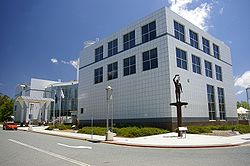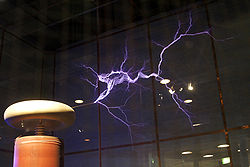- Questacon
-
Questacon - the National Science and Technology Centre 
Established 1986 (opened in 1988) Location Parkes, Australian Capital Territory, Australia Type Science centre Visitor figures 407 000 in Centre (2005-06) Director Professor Graham Durant Website http://www.questacon.edu.au/ Questacon – the National Science and Technology Centre, is located on the southern shore of Lake Burley Griffin in Canberra, Australia. It is a large centre with more than 200 interactive exhibits relating to science and technology.
Contents
History
Questacon – the National Science and Technology Centre is an interactive science centre that opened on November 23, 1988. It was developed by Professor Mike Gore, a physics lecturer from the Australian National University. Professor Gore went on to become the founding Director of Questacon.
Questacon's current building was Japan's gift to Australia for the 1988 Bicentenary and it was opened on 23 November 1988. Japanese government and business contributed ¥1 billion, half of the capital cost of A$19.64 million.[1]
It was formerly housed at the old Ainslie Primary School.
Governance
As of 3 December 2007,[2] Questacon is a part of the Australian Government Department of Innovation, Industry, Science and Research (DIISR). The director is Professor Graham Durant.
Questacon's vision is "a better future for all Australians through engagement with science and innovation".[3]
Simpson review
On Thursday 18 September 2008 a review of Questacon was released.[4] The review was commissioned by Minister Kim Carr and chaired by John Simpson of National Australia Bank. Among other recommendations, the review calls for Questacon to be established as a statutory authority.
Exhibition services
Questacon also have a facility in the industrial suburb of Fyshwick that houses more than 50 staff. All of the outreach programs and the exhibition developers, including researchers, designers and electronics, metal and woodshop staff are based there. The facility also stores unused and decommissioned exhibits.
Exhibitions
 The Tesla coil in the exhibition Awesome Earth at Questacon
The Tesla coil in the exhibition Awesome Earth at Questacon
 A tornado simulator using steam in the same exhibition
A tornado simulator using steam in the same exhibition
The centre is split up into seven galleries on different floors, accessed by a spiral ramp around the 'drum'. As of November 2009, the seven galleries are:
- Terrorsaurus with anamatronic dinosaurs.
- Sideshow, perhaps the most popular exhibition, looking at the science of the circus. Several popular exhibits include Free Fall, a giant slide with a six metre and seventy centimetre drop, and Track Attack, a simulated roller coaster.
- MiniQ, an exhibition designed for children between the ages of 0 and 6. Exhibits include a water play area, a sensory space, and a quiet area.
- Wonderworks, looking at light and sound. The exhibitions features displays on Polarised light, Fresnel lenses, and holograms.
- Awesome Earth, looking at natural disasters and geology. Features a Tesla coil and an earthquake simulator.
- Perception Deception explores how your brain can mix up what you see and hear.
- Measure Island, makes measurement adventurous and fun.
The galleries are staffed by paid staff, as well as a team of about 60 volunteers. The volunteers occasionally will make use of Discovery Trolleys, featuring smaller, hands-on exhibits related to the gallery.
Science theatre
The Centre also features a number of performance spaces, used for presentations for general public and student audiences by Questacon's in-house theatre troupe, the Excited Particles. The Excited Particles also perform puppet shows for young children and more serious talks on science and current events.
Visitation
Last year over 420 000 people visited the Centre in Canberra.
Opening hours
Questacon is open from 9.00am to 5.00pm everyday except Christmas Day. Groups can also book special evening sessions.
Admission
Admission fees are A$20.00 for adults and A$15.00 for children aged 4–16. Admission is free for children under the age of four if accompanied by an adult. There are special rates for families, concessions and groups.
Membership
Q Club members receive unlimited entry to Questacon, as well as entry to many other Australian museums and science centres, and all ASTC member institutions internationally. There is a members' lounge with card entry.
Facilities
The Q Shop offers a range of educational science toys, books and teacher resources. Questacon's cafe is situated in the foyer of the building. An entry fee is not required to visit either the cafe or the Q Shop.
There are toilets throughout the building, including a children's toilet in the Mini Q exhibition. There are two dedicated baby change rooms - one near the café in the foyer and another in Mini Q.
Promotion
Quesatcon's common advertising slogan is "We always make science fun."
Outreach programs
In addition to the exhibitions in Canberra, Questacon also run a large number of outreach programs all over Australia, including the Shell Questacon Science Circus, Tenix Questacon Maths Squad, Questacon Smart Moves, Questacon Science Play and range of activities in remote Indigenous communities.
Around 300 000 people participate in outreach programs each year.
Shell Questacon Science Circus
The Shell Questacon Science Circus is an outreach program of Questacon and is the most extensive science outreach program of its kind in the world. Each year, the Science Circus engages with more than 100 000 people, travels 25 000 kilometers, runs professional development courses for 600 teachers and visits about 30 remote aboriginal communities as well as hospitals, nursing homes and special schools.
The Shell Questacon Science Circus is a partnership between Questacon, the Shell Oil Company Australia and the Australian National University. The Science Circus won the Prime Minister's Award for Community Business Partnerships in 2006. Sixteen science graduates staff the Science Circus as it travels, bringing lively presentations of science to towns and schools. The Science Circus also supports the teaching of science and technology by running practical and fun professional development workshops for teachers. While working for the Science Circus, each presenter also completes a Graduate Diploma in Science Communication through the Centre for the Public Awareness of Science at the Australian National University. Coursework includes studies in print media, programme evaluation and exhibition design.
Every year the Science Circus presenters graduate from the course and a new team are selected. The first team graduated in 1988 and there are now over 300 Science Circus graduates. Graduates have contributed to programmes on Australian Broadcasting Corporation Radio, the Diffusion Science Radio Show, Cosmos Magazine, and the Mr Science Show podcast.
Gallery
References
External links
Coordinates: 35°17′54″S 149°07′53″E / 35.298333°S 149.131389°E
Locations near Lake Burley Griffin, Canberra East Basin Central Basin West Basin Albert Hall · Hotel Canberra · Lennox Gardens · National Museum of Australia · Royal Canberra Hospital · Royal Canberra Hospital implosionWest Lake Spinnaker Island · Springbank Island · Black Mountain Peninsula · Glenloch Interchange · Yarramundi Reach · Lindsay Pryor National Arboretum · National Arboretum Canberra · Scrivener Dam · Government House · Royal Canberra Golf Club · Weston Park · Canberra Yacht Club
Categories:- Museums in Canberra
- Science museums in Australia
- Commonwealth Government agencies of Australia
- National museums of Australia
- 1980 establishments
Wikimedia Foundation. 2010.

